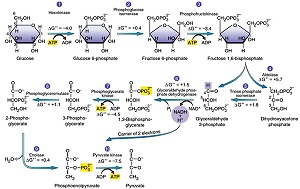Respiration in Plants - Online Test
Q1. The enzyme which converts glucose into glucose -6- phosphate is
Answer : Option A
Explaination / Solution:
A hexokinase is an enzyme that phosphorylates hexoses (six-carbon sugars), forming hexose phosphate. In most organisms, glucose is the most important substrate of hexokinases, and glucose-6-phosphate is the most important product.
Q2. How many step reactions are involved in glycolysis?
Answer : Option A
Explaination / Solution:
Glycolysis is a series of reactions that and extract energy from glucose by splitting it into two three-carbon molecules called pyruvates. Glycolysis is an ancient metabolic pathway, meaning that it evolved long ago, and it is found in the great majority of organisms alive today. Glycolysis has ten steps.

Q3. The partial breakdown of glucose takes place in
Answer : Option B
Explaination / Solution:
Fermentation is an anaerobic breakdown of carbohydrates in which an organic molecule is the final electron acceptor. It does not involve an electron transport system.
Furthermore,: it is a partial breakdown of glucose giving a little energy, 2 net ATP's per glucose by way of substrate-level phosphorylation.
Q4. Which one is incorrect about Glycolysis?
Answer : Option A
Explaination / Solution:
Glycolysis is not a cyclic pathway and carbon dioxide gas is not released during this cycle. Oxygen is not required for Glycolysis process. Glycolysis occurs in cytoplasm of the cell.
Q5. During cellular respiration, pyruvic acid is reduced to lactic acid in the presence of
Answer : Option C
Explaination / Solution:
Lactate dehydrogenase: (LDH) An enzyme that catalyzes the conversion of lactate to pyruvate When oxygen is inadequate for cellular respiration.
This is an important step in energy production in cells. Many different types of cells in the body contain this enzyme. Some of the organs relatively rich in LDH are the heart, kidney, liver, and muscle.
Q6. Energy is stored in the form of
Answer : Option C
Explaination / Solution:
Cells store energy in a molecule called adenosine triphosphate (abbreviated as ATP). The adenosine molecule has three phosphate groups attached to it (triphosphate means three phosphates) which are held together by high energy bonds.
If one of these bonds is broken, a great amount of energy is released which can be used in an endergonic reaction.
Q7. Glycolysis is conversion of
Answer : Option D
Explaination / Solution:
Glycolysis is the metabolic pathway that converts glucose C6H12O6, into pyruvate, CH3COCOO− + H+.
The free energy released in this process is used to form the high-energy molecules ATP (adenosine triphosphate) and NADH (reduced nicotinamide adenine dinucleotide).
Q8. In animal cells, the first stage of glucose break down is
Answer : Option A
Explaination / Solution:
In animal cells, like muscles during exercise, when oxygen is inadequate for cellular respiration pyruvic acid is reduced to lactic acid by lactate dehydrogenase. The reducing agent is NADH+ and H+ which is reoxidised to NAD+ in both the processes.
Q9. Which one is not a preparatory phase or energy spending phase of Glycoloysis
Answer : Option B
Explaination / Solution:
Formation of pyruvate is not a prerparatory phase or energy spending phase of Glycolysis. In this phase one ATP molecule is released.
Q10. Anaerobic respiration of yeast produces
Answer : Option D
Explaination / Solution:
Anaerobic respiration in some microorganisms such as yeast produces ethanol and carbon dioxide, as opposed to lactic acid.
Glucose is achieved under anaerobic conditions by sets of reactions.
It can be summarised by the following equation:
glucose → ethanol + carbon dioxide ( + energy released)
